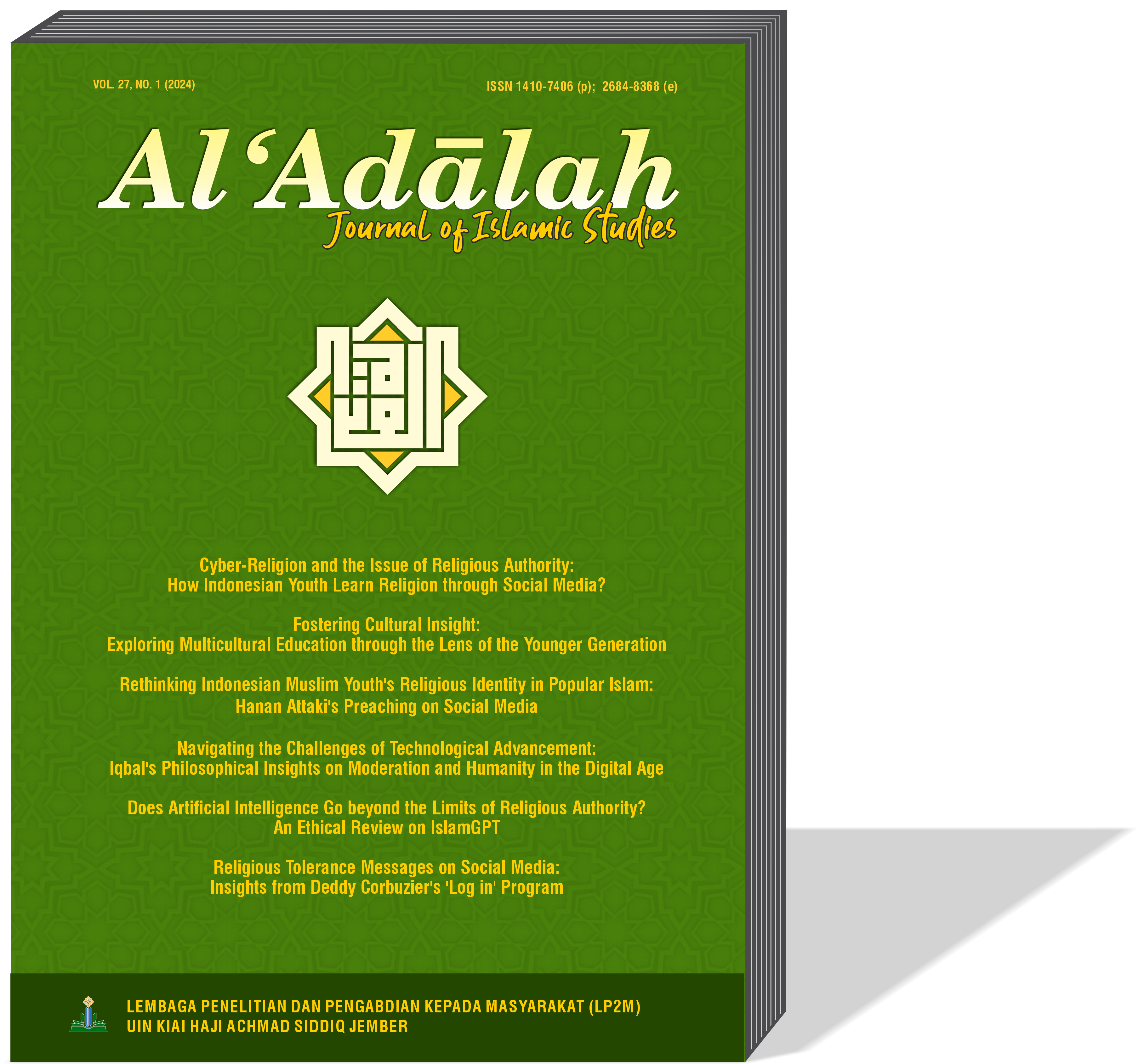Cyber-Religion and the Issue of Religious Authority: How Indonesian Youth Learn Religion through Social Media?
DOI:
https://doi.org/10.35719/aladalah.v27i1.440In recent years, there has been a high increase in social media activity for religious purposes. The abundance of social media activity based on a religious theme excessively emerged, namely online preaching, virtual worship, and a new term called ngaji virtual. This paper uses the phenomenological research method to analyze religious phenomena in social media as a new form of cyberculture, grown excessively during and after the pandemic. Data for this study were collected from 150 respondents who were followers of online religious recitations or lectures on social media platforms, particularly on Facebook, YouTube, and Instagram. This study aims to explain the motives of faith-based social media users, with an additional appraisal of their impact on their daily lives. The results showed numerous motives of faith-based social media users, namely the necessity of information about religion and spiritual enlightenment, and even emphasizing that their worship is valid. Social media as a source of information about religion became more widespread after the pandemic, making social media the primary source for obtaining religious knowledge and growing into a new culture. The emergence of this new cyberculture renders disruption in the religious field, from ethical problems to the problem of obscuring religious authority.
Downloads
References
Alatas, I. F. (2021). What is religious authority? Cultivating Islamic communities in Indonesia. Princeton University Press.
Ancok, D., & Suroso, F. N. (2005). Psikologi Islam: Solusi Islam atas problema-problema psikologi. Pustaka Pelajar.
Anggini, M. D., & KN, J. (2023). Fenomena cyber religion sebagai ekspresi keberagamaan oleh Habib Jafar. Jurnal Pendidikan Tambusai, 7(2), 4140-4149. https://jptam.org/index.php/jptam/article/view/6795
Asosiasi Penyelenggara Jasa Internet Indonesia (APJII). (2018). Penetrasi & Profil Perilaku Pengguna Internet Indonesia. APJII.
Barzilai-Nahon, K., & Barzilai, G. (2005). Cultured technology: The internet and religious fundamentalism. The Information Society, 21(1), 25–40. https://doi.org/10.1080/01972240590895892
Brasher, B. (2001). Give me that online religion. Wiley.
Campbell, H. A. (2013). Religion and the internet: A microcosm for studying internet trends and implications. New Media & Society, 15(5), 680–694, https://doi.org/10.1177/1461444812462848
Chair, B. M., & Adzfar, Z. (2021). Kebenaran di era post truth dan dampaknya bagi keilmuan akidah. Fikrah: Jurnal Ilmu Aqidah dan Studi Keagamaan, 9(2), 265-282. http://dx.doi.org/10.21043/fikrah.v8i1.12596
Cotton, S., Zebracki, K., Rosenthal, S. L., Tsevat, J., & Drotar, D. (2006). Religion/ spirituality and adolescent health outcomes: A review. The Journal of Adolescent Health: Official Publication of the Society for Adolescent Medicine, 38(4): 472–480. https://doi.org/10.1016/j.jadohealth.2005.10.005
Dawson, L.L. (2000). Researching religion in cyberspace: Issues and strategies. In Hadden, J.K., Cowan, D.E. (Eds.), Religion on the internet: Research prospects and promises, 8 (pp. 25-54). JAI Press.
Dawson, L.L., & Cowan, D.E., (2004). Religion online: Finding faith on the internet. Routledge. https://doi.org/10.4324/9780203497609
Flew, T. (2002). New media: An introduction. Oxford University Press.
Fukuyama, F. (1999). The great disruption: Human nature and the reconstitution of social order. Profile Books.
Ghufron, M. N., & Suminta, R. R. (2010). Teori-teori psikologi. Ar-Ruzz Media. https://repository.iainkediri.ac.id/584/1/TEORI-TEORI%20PSIKOLOGI.pdf
Gobber, G. (2019). The scarlet letter of 'post-truth': The sunset boulevard of commu-nication. Communication and Culture, 4(3), 287–304. https://doi.org/10.1080/23753234.2019.1665468
Højsgaard, M., & Warburg, M. (Eds.). (2005). Religion and cyberspace. Routledge.
Husein, F., & Slama, M. (2018). Online piety and its discontent: Revisiting Islamic anxieties on Indonesian social media. Indonesia and the Malay World, 46(134), 80–93. https://doi.org/10.1080/13639811.2018.1415056
Kasali, R. (2017). Disruption. Gramedia.
Kluver, R., & Cheong, P. H. (2007). Technological modernization, the internet, and religion in Singapore. Journal of Computer-Mediated Communication, 12(3), 1122–1142. https://doi.org/10.1111/j.1083-6101.2007.00366.x
Lerner, M. Y. (2010). Connecting the actual with the virtual: The internet and social movement theory in the muslim word—the cases of Iran and Egypt. Journal of Muslim Minority Affairs, 30(4), 555-574. https://doi.org/10.1080/13602004.2010.0533453
Lynn, M. L., Naughton, M. J., & VanderVeen, S. (2011). Connecting religion and work: Patterns and influences of work-faith integration. Human Relations, 64(5), 675-701. https://doi.org/10.1177/0018726710386396
Malik, H. (2021). Cyber religion dan real religion di tengah masyarakat digital. Komunika, 4(1). http://dx.doi.org/10.24042/komunika.v4i1.8615
Nichols, T. (2018). Matinya kepakaran. Gramedia.
Oktavia, N. A., Muhid, A., & Hamidah, L. (2021). Cyber-religion pada generasi Z: Kontribusi mindfulness terhadap penggunaan akun dakwah jejaring sosial sebagai referensi keagamaan. Psikoislamedia: Jurnal Psikologi, 6(1), 108-121. http://dx.doi.org/10.22373/psikoislamedia.v6i1.7939
Pribadi, Y. (2020). Pop and true Islam in urban pengajian: The making of religious authority. In Norshahril S. & A. N. Burhani (Eds.), The new santri: Challenges to traditional religious authority in Indonesia (pp. 213–238). ISEAS-Yusof Ishak Institute.
Rashid, T. (2019). Social media, religion and religiosity in Pakistan in the era of disruption. Hamdard Islamicus, 42(1-2), 33–56. https://hamdardislamicus.com.pk/index.php/hi/article/view/5
Toni, H, Rolando, D. M., Yazid, Y., & Adity, R. (2021). Cyber religion phenomenon as a religious expression on the internet in the Shift Community. Jurnal Dakwah Risalah, 32(1), 56-74. http://dx.doi.org/10.24014/jdr.v32i1.11626
Wan-Chik, R., Clough, P., & Ford, N. (2011). "Searching for Islamic and qur'anic information on the web: A mixed-methods approach [Paper presentation]. Asia Information Retrieval Symposium (AIRS), Information Retrieval Technology (pp. 181–192). Lecture Notes in Computer Science, 7097. Springer. https://doi.org/10.1007/978-3-642-25631-8_17
Wawaysadhya, Oktafiani, T. U., Olivia, P. L. D., & Baruzzaman, M. (2022). Moderasi beragama di media sosial: Narasi inklusivisme dalam dakwah. Al-Munir: Jurnal Komunikasi dan Penyiaran Islam, 13(2), 118-132. http://ejournal.uinib.ac.id/jurnal/index.php/almunir/article/view/4601
Wijaya, A. P., Nugroho, A., Fajrie, M., Haqqi, M. N., Pratama, P., Setyadi , A. U., Setiani, V., & Fania, D. (2023). Praktik cyber religion remaja perkotaan. Jurnal Komunikasi Nusantara, 5(2), 208-217. https://doi.org/10.33366/jkn.v5i2.404
Yu, Q. (2022). Simulation of the interactive prediction of contemporary social change and religious socialization based on big data. Technological Forecasting and Social Change, 184. https://doi.org/10.1016/j.techfore.2022.122038
Zaman, S. (2008). From imam to cyber-mufti: Consuming identity in muslim America. The Muslim Word, 98(4), 465–474. https://dx.doi.org/10.1111/j.1478-1913.2008.00240.x
Downloads
Section
License
Copyright (c) 2024 Badrul Munir Chair, Wawaysadhya, Tri Utami Oktafiani

This work is licensed under a Creative Commons Attribution-NonCommercial 4.0 International License.
This work is licensed under a Attribution-NonCommercial 4.0 International (CC BY-NC 4.0).

























 Al'Adalah licensed under Creative Commons Attribution-NonCommercial 4.0 International License.
Al'Adalah licensed under Creative Commons Attribution-NonCommercial 4.0 International License.